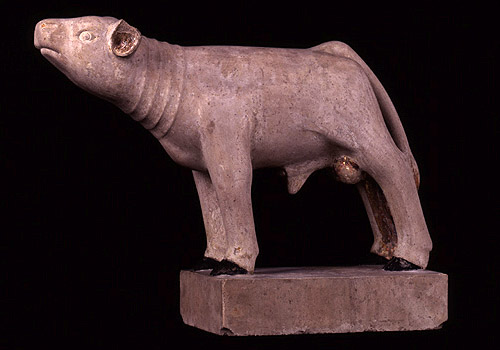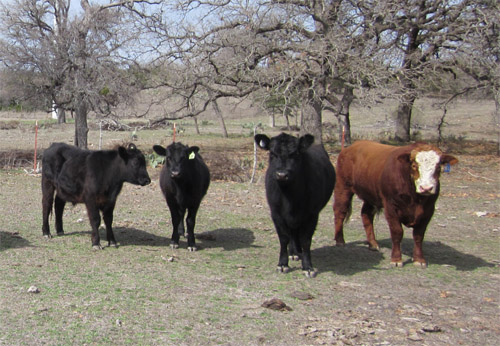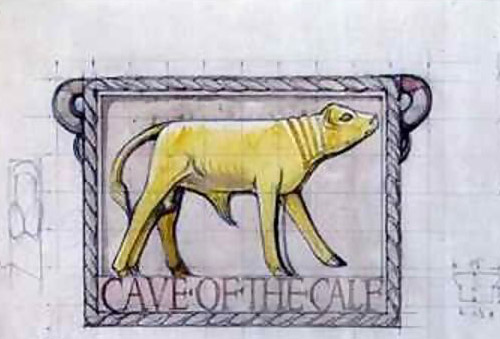
Image Credit: Harry Ransom Center
Eric Gill’s Calf is currently on display at the Harry Ransom Center as part of their new exhibition The King James Bible: Its History and Influence. The calf first appears in the King James Bible in the following verses. “Make us gods, which shall go before us... And Aaron said unto them, Break off the golden earrings, which are in the ears of your wives, of your sons, and of your daughters, and bring them unto me...And he received them at their hand, and fashioned it with a graving tool, after he had made it a molten calf: and they said, These be thy gods, O Israel, which brought thee up out of the land of Egypt (Exodus 32:1-4). In both the statue and in this chapter of Exodus we can begin to consider the relationship between these humans and gods and animals.
The molten calf, bought and paid for with the recently freed people’s golden jewelry, isn’t an idol intended for the veneration of animals. Instead, it seems as though this golden calf is taken up and used by humans just as an actual calf might be. The calf remains a beast. Derrida’s in his recently published lectures The Beast and Sovereign proposed that culturally both the beast and the sovereign have been perceived as operating outside the scope of law--the sovereign because his actions operate as the law and the beast because it is incapable of stupidity, and without the ability to respond it only ever reacts.

Image Credit: Steven LeMieux
We see this same configuration played out upon the body of the golden calf. It is rendered as both animal and god, doubly beyond the scope of the law (and it was precisely when Moses was receiving the commandments that his errant followers took up with the calf). And with both gods and animals outside the scope of the law they become null spaces. Humans then build law, desire, impetus upon their bodies. The calf is constructed not so that they might follow it but rather so that they might drive it before them. Even as they chase it its flight and footsteps are rendered as guidance. The golden calf is caught up in human use just as much as its fleshy fellows.

Image Credit: Eric Gill via 1st-art-gallery.com
Gill’s statue plays along these lines. It is both innocent and virile. The calf’s outstretched head with its slight frown and large, vacant eyes gives it the look of a newborn creature. It sees all the world in a dull wonder. The statue also prominently features its penis and set of still gilded scrotum. The statue, made of hoptonwood stone in 1912, was originally gilded. Over time, though, most of the gilding has flaked off. Gill’s involvement with the calf, though, didn’t follow the same purpose as much of his religious works. He designed the calf for the newly created avant-garde nightclub the Cave of the Golden Calf.
With this we might begin to look at the decadence heaped upon both the images of the calf and its representation in Exodus. “And it came to pass, as soon as he came nigh unto the camp, that he saw the calf, and the dancing: and Moses' anger waxed hot, and he cast the tables out of his hands, and brake them beneath the mount. And he took the calf which they had made, and burnt it in the fire, and ground it to powder, and strewed it upon the water, and made the children of Israel drink of it” (Exodus 19-20). Moses, displeased with the tenor of the celebration surrounding the calf, forces the people to eat their calf—one use is simply turned to another. And with the calf eaten he replaced the nascent path built upon the body of the animal with his textual commandments.



Recent comments
2 years 29 weeks ago
2 years 44 weeks ago
2 years 44 weeks ago
2 years 50 weeks ago
3 years 4 weeks ago
3 years 4 weeks ago
3 years 4 weeks ago
3 years 6 weeks ago
3 years 6 weeks ago
3 years 6 weeks ago